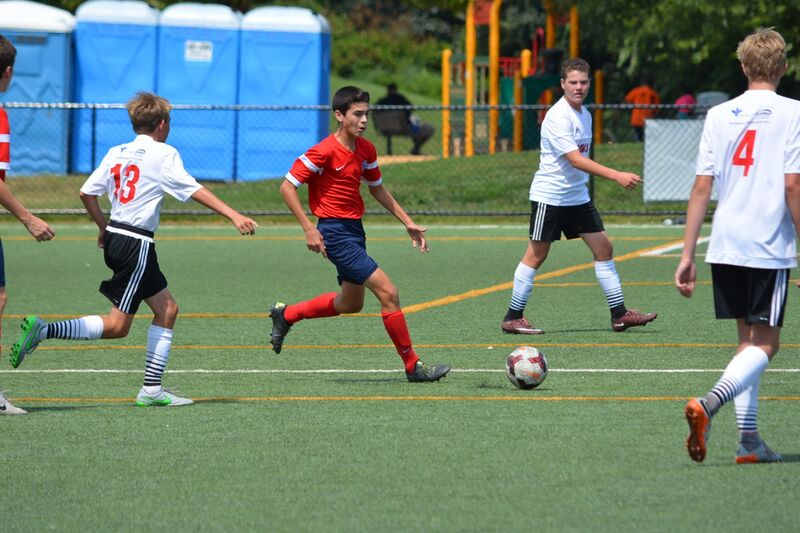Artificial turf and cancer: ESPN digs into crumb rubber risks with troubling E:60 report by Julie Foudy

ESPN dragged the troublesome links between artificial turf and cancer back into the national spotlight on Tuesday night, airing an “E:60” investigative report on the topic led by former U.S. Women’s National Team star Julie Foudy (watch below).
 Following in the footsteps of an NBC News investigation last year, “The Turf War” explores the anecdotal evidence that soccer players – especially young ones – are at risk due to the toxic cocktail of chemicals found in crumb rubber, the tiny bits of recycled auto tires used as infill in most modern turf surfaces.
Following in the footsteps of an NBC News investigation last year, “The Turf War” explores the anecdotal evidence that soccer players – especially young ones – are at risk due to the toxic cocktail of chemicals found in crumb rubber, the tiny bits of recycled auto tires used as infill in most modern turf surfaces.
Like NBC’s Hannah Rappleye did, Foudy speaks with University of Washington women’s goalkeeper coach Amy Griffin, who saw so many young athletes around her stricken with leukemia and other forms of cancer that she began compiling a list of them. Griffin’s list now runs to 187 people in total, 150 of them soccer players – and of those, 95 are goalkeepers, who may experience additional exposure due to their increased contact with playing surfaces.
+READ: Does artificial turf cause cancer? NBC News’ alarming report
“When I was with the federal government, we would’ve called that an outbreak,” said David Brown, a toxicologist and former employee of the National Centers for Disease Control and Prevention who spoke to SoccerWire.com about this issue a year ago.
Officially, the CDC and the Environmental Protection Agency have yet to classify crumb rubber as a known health hazard, citing a lack of clear clinical proof. But Brown and other experts featured in the E:60 piece express serious concerns about the effects of a substance which has been found to contain 12 known carcinogens, and is a main ingredient in some 12,000 playing fields around the United States.
“I think they’re in the air you inhale,” Brown told Foudy of the chemicals in question. “The problem with the soccer players is that they’re diving into the crumb rubber. I think they’re actually ingesting it.
“Young children have incomplete development systems and they tend to keep it in the body longer. The longer it’s in your body, the bigger the problem.”
+READ: Former CDC toxicologist unsurprised by alleged link between artificial turf, cancer
Perhaps the most useful element of ESPN’s reporting is the exploration of how crumb rubber became such a common substance in American sports. It seems that its widespread use dates back to a pressing need to recycle the hazardous waste created by used car tires, rather than a desire to help grow the nation’s sporting infrastructure.
https://www.youtube.com/watch?v=qhHmlyoTj9M
“Let’s make lemonade out of this lemon. Let’s take this waste and turn it into a product,” said Jeff Ruch, a lawyer with environmental advocacy group Public Employees for Environmental Responsibility (PEER). “It was a solution to a solid waste problem that had a public-health blind spot.
“The way we do things in this country, we for the most part operate on the principle that a chemical is innocent until proven guilty. It goes into the stream of commerce and only if it produces a body count is there then any sort of regulatory response. Despite promoting that practice, EPA had never done a risk assessment.”
+LEBOLT: Synthetic turf cancer risk tiny compared to more sedentary lifestyle alternative
Even though it plays up frightening imagery and heartbreaking accounts of cancer deaths, the E:60 piece does not reach a definitive conclusion about turf’s links to cancer. But it does illuminate the startling lack of in-depth clinical research on the matter: Foudy notes that “there is no single study that has looked at long-term exposure to crumb rubber, which can occur through inhalation, ingestion or contact with open wounds.”
ESPN managed to get EPA head Gina McCarthy to sit down with Foudy for an interview, an impressive feat given the organization’s longstanding evasion and avoidance of this topic.
McCarthy’s words are unlikely to give advocates much hope of meaningful governmental action in the near term. Yet the rising tide of public attention – a process that mainstream media coverage can lead as well as anyone – could prove to be the most influential factor in forcing further research into the risks of crumb rubber and the fields that are built with it.











